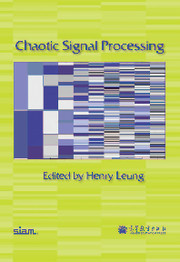Description
Chaotic Signal Processing
Language: English
Subject for Chaotic Signal Processing:
Publication date: 03-2014
185 p. · 17.8x25.4 cm · Paperback
Withdrawn from sale
185 p. · 17.8x25.4 cm · Paperback
Withdrawn from sale
Description
/li>Contents
/li>Biography
/li>
Chaotic processes are deterministic phenomena which display a random appearance. Many signal processes such as radar and sonar appear random, and chaos theory provides an alternative approach to processing these signals. This book presents a thorough guide to recent developments in chaotic signal processing. This includes the application of nonlinear dynamics to radar target recognition, an exactly solvable chaos approach for communications, a chaotic approach for reconfigurable computing, and system identification using chaos. It also investigates the design of a high resolution LADAR system based on chaos, and the use of chaos in compressive sensing. Suitable for researchers and graduate students in chaos, applied nonlinear dynamics, signal processing and radar communications.
Preface; 1. An overview of chaotic signal processing Henry Leung; 2. Target recognition using nonlinear dynamics T. L. Carroll and F. J. Rachford; 3. Communicating with exactly solvable chaos Ned J. Corron, Jonathan N. Blakely and Shawn D. Pethel; 4. Logic from dynamics William L. Ditto, Abraham Miliotis, K. Murali and Sudeshna Sinha; 5. System identification using chaos Henry Leung and Ajeesh Kurian; 6. Characterization and optimization of a chaotic LADAR system for high resolution range determination Berenice Verdin and Benjamin C. Flores; 7. Reverse engineering of complex dynamical systems based on compressive sensing Ying-Cheng Lai; Index.
Henry Leung is a Professor in the Department of Electrical and Computer Engineering of the University of Calgary, Canada. Previously, he was with the Department of National Defence (DND) of Canada as a defence scientist, where he conducted research and development of automated surveillance systems. His current research interests include adaptive systems, computational intelligence, data mining, information fusion, robotics, sensor networks, signal processing and wireless communications. He was awarded the Mountbatten Premium by the Institution of Electrical Engineers for his work on applying chaos and fractals to radar signal processing.
© 2024 LAVOISIER S.A.S.

